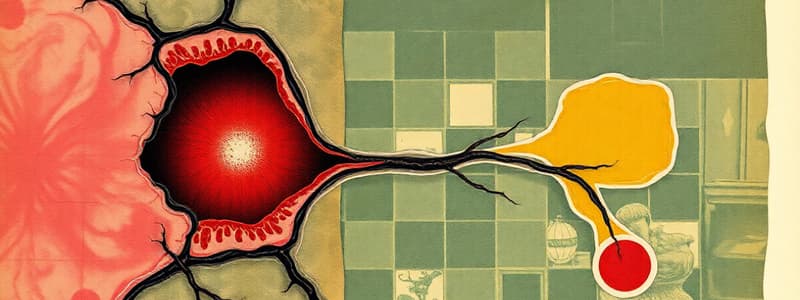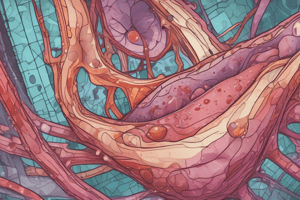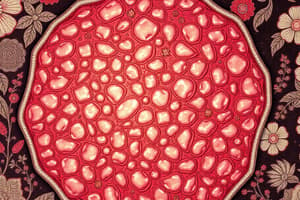Podcast
Questions and Answers
What is the primary purpose of the inflammatory phase in wound healing?
What is the primary purpose of the inflammatory phase in wound healing?
- To form a durable scar tissue
- To prevent infection and septicemia (correct)
- To facilitate fibroblast infiltration
- To promote maximum tissue regeneration
During which phase of wound healing does debridement primarily occur?
During which phase of wound healing does debridement primarily occur?
- Coagulation
- Maturation
- Debridement (correct)
- Proliferation
Which cells are mainly responsible for the initial controlling of bleeding in wound healing?
Which cells are mainly responsible for the initial controlling of bleeding in wound healing?
- Platelets (correct)
- Macrophages
- Neutrophils
- Fibroblasts
What process is characterized by the invasion of fibroblasts into the wound area?
What process is characterized by the invasion of fibroblasts into the wound area?
What is the final phase of wound healing focused on restoring appearance and function?
What is the final phase of wound healing focused on restoring appearance and function?
In which condition can paradoxical embolization occur?
In which condition can paradoxical embolization occur?
What is the main reason embolism is less likely to occur in veins compared to arteries?
What is the main reason embolism is less likely to occur in veins compared to arteries?
Which type of emboli is composed of a blood clot that dislodges from its original site?
Which type of emboli is composed of a blood clot that dislodges from its original site?
Where do emboli originating from peripheral veins typically end up?
Where do emboli originating from peripheral veins typically end up?
Which statement regarding systemic embolization is correct?
Which statement regarding systemic embolization is correct?
What type of thrombi is primarily associated with platelet aggregation?
What type of thrombi is primarily associated with platelet aggregation?
In which situation would heparin be most appropriately used?
In which situation would heparin be most appropriately used?
What is a major consequence of disseminated intravascular coagulation (DIC)?
What is a major consequence of disseminated intravascular coagulation (DIC)?
Which type of thrombus is specifically associated with endocarditis?
Which type of thrombus is specifically associated with endocarditis?
What does migrating thrombophlebitis indicate in a patient?
What does migrating thrombophlebitis indicate in a patient?
What triggers the generalized activation of the clotting cascade in DIC?
What triggers the generalized activation of the clotting cascade in DIC?
What characteristic is typical of red thrombi?
What characteristic is typical of red thrombi?
Which of the following conditions is an acute cause of DIC?
Which of the following conditions is an acute cause of DIC?
What occurs during overactivation of fibrinolysis in the context of DIC?
What occurs during overactivation of fibrinolysis in the context of DIC?
What best describes fibrinolytic imbalance?
What best describes fibrinolytic imbalance?
What is a consequence of the depletion of clotting factors in consumptive coagulopathy?
What is a consequence of the depletion of clotting factors in consumptive coagulopathy?
What causes hemorrhagic complications associated with high levels of plasmin?
What causes hemorrhagic complications associated with high levels of plasmin?
What characterizes the vicious cycle seen in DIC?
What characterizes the vicious cycle seen in DIC?
Which of the following is primarily affected by excessive fibrinolysis?
Which of the following is primarily affected by excessive fibrinolysis?
What is the primary result of the imbalance between clot formation and clot breakdown?
What is the primary result of the imbalance between clot formation and clot breakdown?
What complication arises due to the inhibition of coagulation factors like fibrinogen?
What complication arises due to the inhibition of coagulation factors like fibrinogen?
Which statement accurately describes the composition of the pale layers in thrombi?
Which statement accurately describes the composition of the pale layers in thrombi?
What do Lines of Zahn indicate about a thrombus?
What do Lines of Zahn indicate about a thrombus?
What role do female hormones play in thrombus formation?
What role do female hormones play in thrombus formation?
What characterizes the dark layers in a thrombus?
What characterizes the dark layers in a thrombus?
Which condition can promote frequent thrombus formation?
Which condition can promote frequent thrombus formation?
How does the presence of thrombus affect blood circulation?
How does the presence of thrombus affect blood circulation?
What is a potential complication of prolonged thrombus formation in pregnant women?
What is a potential complication of prolonged thrombus formation in pregnant women?
What typically distinguishes arterial thrombi from venous thrombi?
What typically distinguishes arterial thrombi from venous thrombi?
What distinguishes ante-mortem thrombi from post-mortem clots?
What distinguishes ante-mortem thrombi from post-mortem clots?
Which of the following accurately describes the formation of a thrombus?
Which of the following accurately describes the formation of a thrombus?
What indicates the potential fate of a thrombus if it does not dissolve?
What indicates the potential fate of a thrombus if it does not dissolve?
What is one of the roles of aspirin in relation to thrombi?
What is one of the roles of aspirin in relation to thrombi?
What process involves the degradation of a thrombus?
What process involves the degradation of a thrombus?
When a thrombus forms in a vessel, what can potentially occur at the nearest branching point?
When a thrombus forms in a vessel, what can potentially occur at the nearest branching point?
What occurs after a thrombus is organized?
What occurs after a thrombus is organized?
Which type of thrombus is most commonly associated with myocardial infarction?
Which type of thrombus is most commonly associated with myocardial infarction?
What do elevated levels of fibrin degradation products (FDPs) and D-dimers indicate?
What do elevated levels of fibrin degradation products (FDPs) and D-dimers indicate?
Which of the following is NOT a consequence of disseminated intravascular coagulation (DIC)?
Which of the following is NOT a consequence of disseminated intravascular coagulation (DIC)?
What characterizes a hemorrhagic diathesis?
What characterizes a hemorrhagic diathesis?
Which condition is associated with the presence of emboli?
Which condition is associated with the presence of emboli?
What is the primary cause of symptoms like cerebral hemorrhage and petechiae in patients with DIC?
What is the primary cause of symptoms like cerebral hemorrhage and petechiae in patients with DIC?
Which type of thrombosis combines inflammation with thrombus formation?
Which type of thrombosis combines inflammation with thrombus formation?
Which of the following statements about emboli is accurate?
Which of the following statements about emboli is accurate?
What is a key feature of microangiopathic hemolytic anemia?
What is a key feature of microangiopathic hemolytic anemia?
Flashcards
Wound Healing
Wound Healing
The process of restoring damaged tissue to its original state or a functional equivalent.
Wound Healing Cascade
Wound Healing Cascade
A series of overlapping events involving cell-to-cell and cell-to-matrix interactions that occur in a coordinated manner to repair a damaged tissue.
Coagulation
Coagulation
The initial phase of wound healing where blood clots form to prevent further bleeding and isolate the wound from the environment.
Inflammation
Inflammation
Signup and view all the flashcards
Proliferation and Migration
Proliferation and Migration
Signup and view all the flashcards
Thrombus
Thrombus
Signup and view all the flashcards
Lines of Zahn
Lines of Zahn
Signup and view all the flashcards
Thrombogenic Conditions
Thrombogenic Conditions
Signup and view all the flashcards
Thrombus Formation in Pregnancy
Thrombus Formation in Pregnancy
Signup and view all the flashcards
Vena Cava Compression
Vena Cava Compression
Signup and view all the flashcards
Blood Coagulation
Blood Coagulation
Signup and view all the flashcards
Adenocarcinoma
Adenocarcinoma
Signup and view all the flashcards
Mucin
Mucin
Signup and view all the flashcards
What is a thrombus?
What is a thrombus?
Signup and view all the flashcards
What are Lines of Zahn?
What are Lines of Zahn?
Signup and view all the flashcards
What are Thrombogenic Conditions?
What are Thrombogenic Conditions?
Signup and view all the flashcards
What are Post-mortem Clots?
What are Post-mortem Clots?
Signup and view all the flashcards
What are Ante-mortem Thrombi?
What are Ante-mortem Thrombi?
Signup and view all the flashcards
What is Thrombus Dissolution?
What is Thrombus Dissolution?
Signup and view all the flashcards
What is Thrombus Embolization?
What is Thrombus Embolization?
Signup and view all the flashcards
What is Thrombus Organization?
What is Thrombus Organization?
Signup and view all the flashcards
What is an arterial thrombus?
What is an arterial thrombus?
Signup and view all the flashcards
What is a venous thrombus?
What is a venous thrombus?
Signup and view all the flashcards
What is a vegetation?
What is a vegetation?
Signup and view all the flashcards
What is an infected thrombus?
What is an infected thrombus?
Signup and view all the flashcards
What is migrating thrombophlebitis?
What is migrating thrombophlebitis?
Signup and view all the flashcards
What is a tumor thrombus?
What is a tumor thrombus?
Signup and view all the flashcards
What is DIC (Disseminated Intravascular Coagulation)?
What is DIC (Disseminated Intravascular Coagulation)?
Signup and view all the flashcards
What is Disseminated Intravascular Coagulation (DIC)?
What is Disseminated Intravascular Coagulation (DIC)?
Signup and view all the flashcards
How does fibrinolysis play a role in DIC?
How does fibrinolysis play a role in DIC?
Signup and view all the flashcards
Describe the imbalance in DIC.
Describe the imbalance in DIC.
Signup and view all the flashcards
What is consumptive coagulopathy?
What is consumptive coagulopathy?
Signup and view all the flashcards
How does DIC lead to hemorrhagic complications?
How does DIC lead to hemorrhagic complications?
Signup and view all the flashcards
What is hemorrhagic diathesis?
What is hemorrhagic diathesis?
Signup and view all the flashcards
Embolism
Embolism
Signup and view all the flashcards
Systemic Embolism
Systemic Embolism
Signup and view all the flashcards
Pulmonary Embolism
Pulmonary Embolism
Signup and view all the flashcards
Paradoxical Embolism
Paradoxical Embolism
Signup and view all the flashcards
Thromboembolus
Thromboembolus
Signup and view all the flashcards
What are Fibrin Degradation Products (FDPs)?
What are Fibrin Degradation Products (FDPs)?
Signup and view all the flashcards
What are D-dimers?
What are D-dimers?
Signup and view all the flashcards
What is Microangiopathic Hemolytic Anemia (MAHA)?
What is Microangiopathic Hemolytic Anemia (MAHA)?
Signup and view all the flashcards
What is an embolus?
What is an embolus?
Signup and view all the flashcards
What is Pylethrombosis?
What is Pylethrombosis?
Signup and view all the flashcards
What is Deep Vein Thrombosis (DVT)?
What is Deep Vein Thrombosis (DVT)?
Signup and view all the flashcards
Study Notes
Wound Healing Cascades
- Wound healing involves overlapping, stereotypical events
- Coordinated interactions between cells and the extracellular matrix (ECM) occur
- Initial steps include bleeding, coagulation, and isolation of the wound from the environment. This stage takes minutes to an hour.
Inflammation
- Inflammation prevents infection and sepsis
- Neutrophils, then macrophages, are involved
- Debridement, the elimination of damaged tissue, begins about a day after injury. Macrophages play a crucial role in this process.
Proliferation and Migration
- Tissue replenishment starts about 3 days after the injury
- Fibroblasts, new capillaries, and parenchymal cells are involved
- This phase helps rebuild the lost tissue.
Epithelialization, Angiogenesis, and Fibroplasia
- Epithelialization is the regeneration of the damaged epithelium
- Angiogenesis supplies the granulation tissue with nutrition
- Fibroplasia involves fibroblast invasion and matrix production. This is crucial for building new tissue.
Remodeling and Contraction
- Remodeling involves the generation and degeneration of the ECM. This stage is essential to build long term strength and stability of the tissue.
- Contraction involves bringing the wound edges closer together.
- Resolution involves restoring the original appearance and function of the tissue.
Maturation
- Collagen type III is initially formed, followed by a transition to stronger collagen type I. The orientation of these collagen fibres becomes more perpendicular over time; this strengthens the repaired tissue.
Basic Steps of Tissue Regeneration
- Tissue damage occurs
- Bacteria may be involved
- The process involves sequential stages including bleeding, coagulation, inflammation, proliferation, epithelialization, angiogenesis, fibroplasia, remodeling, contraction and maturation.
Studying That Suits You
Use AI to generate personalized quizzes and flashcards to suit your learning preferences.





